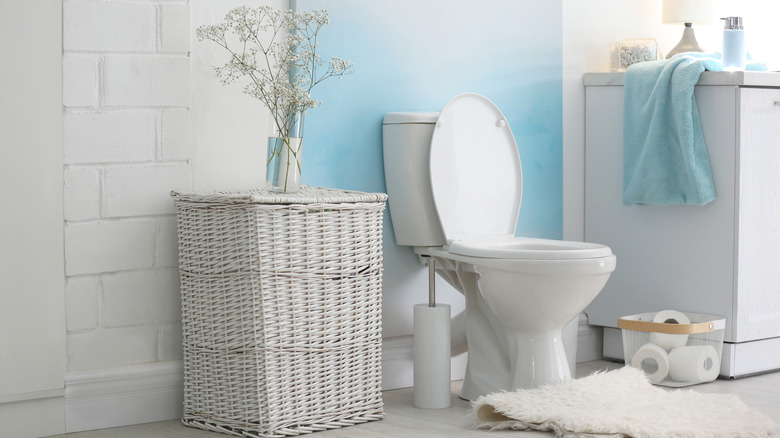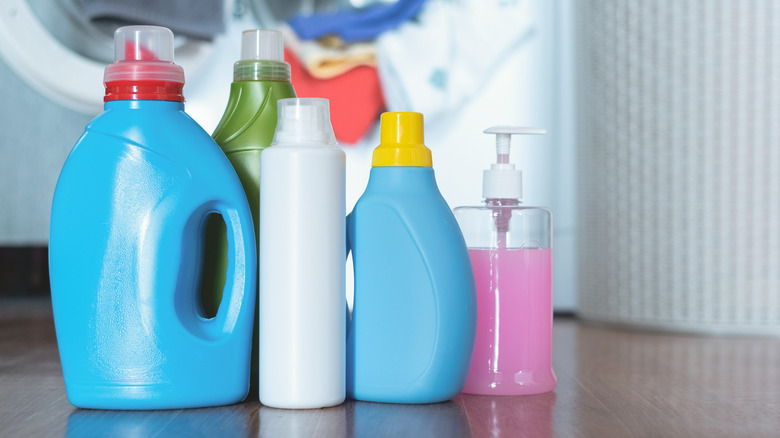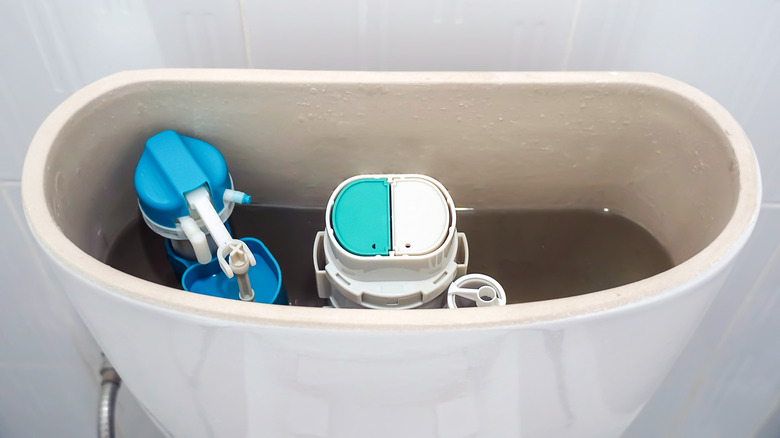This Is What Happens When You Put Fabric Softener In Your Toilet Tank
If you've been poking around the internet lately, then we're willing to bet you saw this hack hit the headlines: According to a TikTok user, the best way to keep your bathroom smelling fresh around the clock is actually already in your laundry room. The user, and many other homeowners on the vast world of social media, insist that pouring a cup of fabric softener directly into your toilet tank is the key to a constantly clean-smelling bathroom. Hundreds of thousands of viewers liked the video, with many commenting that they're giving this easy trick a shot in their own toilet tanks.
There's little doubt that the hack is effective — who wouldn't want to have the house smelling like a fresh load of laundry each and every time someone flushes? But, at the end of the day, some hacks are hacks for a reason. It might be tempting to pour your favorite scent of Downy in the tank and let the bubbles do their thing flush after flush, but sadly, this one may just be too good to be true.
Sure, the fragrance of the fabric softener will fill your bathroom — and probably the whole floor — but at what cost? Some plumbers warn that this hack is a recipe for disaster on any septic system due to the chemical makeup of the softener itself.
Fabric softener could ruin your bathroom plumbing
The only thing worse than a smelly bathroom is clogged pipes — and while this TikTok trick will fix the former, it's sure to cause the latter, too. Godby Heating, Plumbing, and Electrical advises homeowners to ignore this fabric softener fad, since it'll cause a slimy residue coating all over your pipes. Flush that idea down the drain!
Truth or Fiction debunked the reliability of this trick back in 2020, and explained that fabric softener is a major no-go since it's hydrophobic and not water soluble. On top of that, the water in your toilet is cold, making it even harder for the softener to fully break down. Each time you flush the tank, you may be thinking that you're flushing away some of that softener, but that's not the case — instead, the fatty compounds that make up the cleaner will stick onto loose pieces, pipes, and any material surface of the tank. Over time, you might add more and more softener, and the build-up will only continue.
So what's the harm in those pipes being coated in some clean linen smelling soap, you might ask? Well, many professional cleaners use fabric softener to remove stubborn wallpaper from walls, since it helps loosen the adhesive material. When dumped in the toilet tank, it's very likely that too much softener could loosen some pieces and pipes, and ultimately ruin the mechanics of your toilet's flushing system.
There are natural solutions that are safer on your pipes
The good news is you can still have a fabulously smelling bathroom without a drop of fabric softener (and without any elbow grease, too — we promise). Save your septic system and opt for a more natural option instead!
Express Plumbing Idaho doubles down on the warning to stop the softener hack in its tracks. The company even likens it to pouring cooking grease down the kitchen sink, and we all know that's just asking for plumbing trouble, too. Instead, Express Plumbing recommends swapping the softener for an equal amount of distilled white vinegar, which won't wreak havoc on your pipes. Vinegar is a great environmentally friendly deodorizer that will help neutralize any unpleasant odors. Your bathroom won't smell like warm, fluffy towels fresh out of the dryer, but you can always add a candle or air freshener into the mix to pick up the slack!


